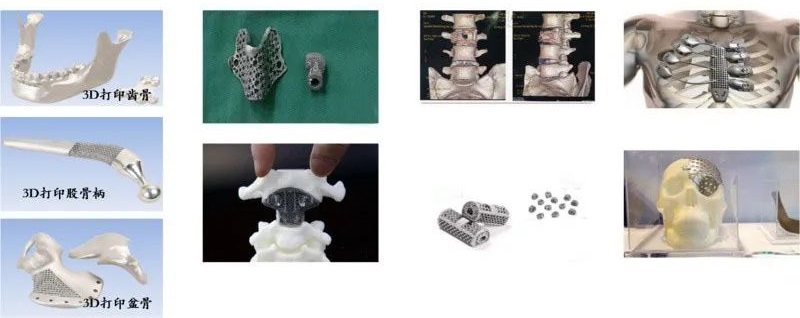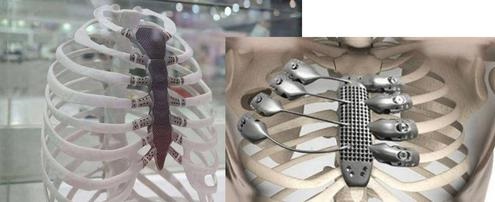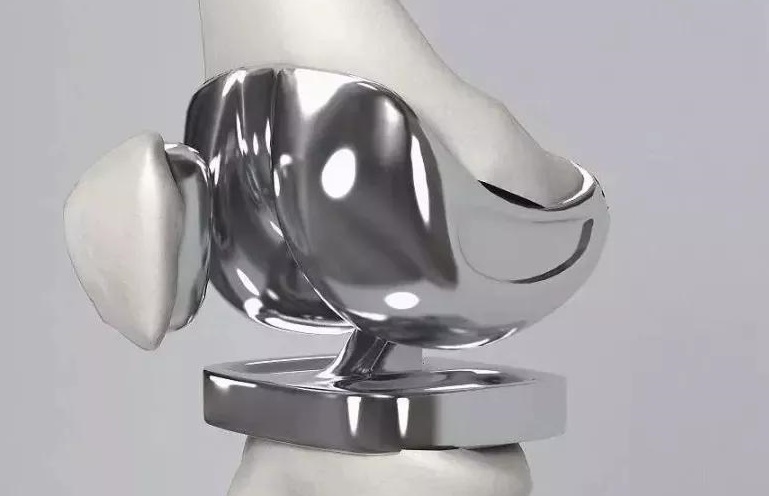3D printing titanium process

Compared with the traditional process, the advantages of 3D printing technology to manufacture personalized surgical implant figures are mainly reflected in: 3D printing free forming characteristics can quickly and accurately customize the internal implant, can overcome the traditional universal implant figure shape is incompatible with the human body and its mechanical properties are not up to standard problems; In the manufacture of complex structures and difficult-to-process products, personalized micro-structures, especially porous through structures, can not only meet specific physical and chemical properties, but also enhance biohistocompatibility. This series of advantages can effectively overcome the common problems of stress shielding and low biological activity of implants. At present, the most commonly used and widely used 3D printing titanium alloys are SLM technology and EBM technology.
Selective Laser Melting (SLM) uses laser as a heat source to selectively irradiate pre-laid powder materials to achieve rapid melting forming. The main working principle is that under the inert gas protection environment, the instrument and equipment control the laser beam according to the filling scanning path generated by the system design mode to select and melt each layer of powder. Then the platform is moved down, powder is laid again and sintering is repeated until the whole shape is formed. The inert gas protection prevents the metal from reacting with other gases at high temperatures. SLM technology is very wide range of forming materials, material saving and recyclable, do not need to design and prepare complex support system, this series of advantages make SLM technology is more and more widely used. However, SLM also has some drawbacks: because of the limited laser power and scanning galvanometer deflection Angle, the size range of parts prepared by SLM will be limited; High-power lasers and high-quality optical equipment are expensive to manufacture, which increases the economic burden to some extent. Due to the use of powder materials in SLM technology, the surface quality of the molded parts may be problematic, which requires secondary processing of the product to be used for subsequent work; Spheroidization and warping defects may also occur in the processing process, which requires a further step to strictly optimize the processing procedure Electron beam melting, EBM is a process that uses electron beam as heat source to melt metal powder layer by layer in vacuum environment for additive manufacturing. Its working principle is: pre-coated powder, high-energy electron beam deflection after focusing to produce high energy in the local small area to scan the powder layer to produce high temperature and even melt, through the electron beam continuous scanning to produce energy between the melt pool fusion and solidification, connected into a linear and planar metal layer. After finishing the current layer, repeat the powder laying operation to form. In the production process, EBM adopts the true air melting environment to ensure the high strength of the material and avoid the oxidation of the alloy. Compared with SLM, the main advantages of EBM are: the efficient generation of electron beam power consumes less power, the production speed is high, so that the actual total power of the whole machine is high; The deflection of the electron beam does not need to move the equipment part, which further improves the scanning speed. The good thermal environment ensures the shape stability of 3D printed parts, ensures its static mechanical properties, meets biological requirements, and the metal powder can also be recycled.
The status and progress of 3D printed surgical implants
Surgical implants and orthotics with 3D printing have a promising application prospect in the field of osteology. Now there are more and more 3D printed implant materials such as hearing AIDS, prosthetic limbs, personalized orthopedic surgery guides, artificial joints, artificial outer ears, personalized dental implants and other applications in clinical personalized treatment. According to reports, in 2014, researchers at Peking University successfully implanted a 12-year-old boy with a personalized 3D printed artificial spine with micro-holes, which was the first case in the world. In the same year, doctors and scientists fitted a 5-year-old girl in Scotland with a 3D printed prosthetic palm. The Stomatology Specialty Center of the 411th Hospital of the People’s Liberation Army successfully used EBM technology to custom and implant a mandibular titanium alloy implant with highly personalized simulation of anatomy for a hemimaxillary resection patient. During the operation, the resection of the diseased mandible and individualized functional repair were completed in one time, and the defective mandible was individually repaired and reconstructed. The postoperative effect was satisfactory. Lethaus B and other researchers used 3D printing technology to reconstruct bone and microvascular flaps in 20 patients with mandibular resection, which shortened the operation time and improved the operation quality, and the postoperative effect was good. In recent years, similar news and research have emerged in an endless stream, which fully reflects the good application prospects of 3D printing in the medical field.

On the side of orthopedic products, 3D printed surgical implant materials are also gradually moving toward commercialization and marketization. In 2007, bioprinted 3D printed acetabulum cups with hard tissue scaffolders developed by Italian company Adler Ortho and LIma-LTO passed CE certification. Exactech’s product was approved by FDA in 2010. In 2009, the all-titanium body fusion device produced by the American AMT company using 3D printing also passed the EU CE certification. In 2013, the first bioprinted skull implant product in the United States was approved by the FDA, which is also the world’s first personalized 3D printed PEEK skull implant figure. On this basis, in 2014, the United States Oxford Company received FDA approval for 3D printing maxillofacial bone products (5IOK mode). In addition, it is reported that in September 2015, the 3D printed human implant – artificial hip joint developed by the Third Hospital of Beijing Medicine and Beijing Aikang Yicheng Medical Equipment Co., LTD., has been registered by the State Food and Drug Administration. The 3D printed hip joint has entered the “mass production stage”, which means that China’s 3D printing implants have also stepped into the stage of production.
3D printing technology has shown an increasingly important role in medical science and technology innovation, and the research and application of various personalized implant prostheses, prosthetic limbs, dental implants and other aspects are also more and more extensive. So, the biosafety evaluation of implants prepared by this new process needs more and more attention.
Research on biosafety of 3D printing titanium
The safety of biomedical materials is mainly reflected in the interaction between tissues and materials. In order for biomedical metal materials to meet the standards of implanted devices, it must be required that the reaction caused by implantation in the human body is at an acceptable level, and at the same time, it cannot induce qualitative changes in the structure and properties of the material. The interaction between human body and human body is mainly reflected in its biocompatibility and biological function. Therefore, after implantation in human body, the implant should not cause adverse reactions such as allergy, inflammation and chemistry in human cells, blood and organs, or the rejection of human foreign bodies. At the same time, it is also required that the implants that need to be implanted for a long time must have good static mechanical properties, that is, sufficient strength, appropriate elastic modulus, high stability, good corrosion resistance and durable durability. Now the surgical implantation of titanium alloy is widely used in clinical practice, and the biocompatibility research is also mature. Therefore, the safety of titanium alloy parts related to 3D printing mainly focuses on the safety of its biomechanical function.

The research on whether the 3D printed metal implant is comparable to the general implant products of the traditional process in terms of mechanical properties, corrosion resistance and biocompatibility, and whether some of the static mechanical properties of the alloy implant can meet the clinical application and national standards is still in progress. It has been found that the partial static mechanical properties of 3D printed titanium implants can meet clinical needs. Ti6A14V samples prepared by EBM technique were tested by direct tensile test and hot isostatic pressing test. The results showed that the strength of TI6A14V samples exceeded the forging standard. The corrosion resistance of the Co-Cr-Mo alloy prepared by the SLM technology is similar to that of the alloy prepared by the traditional process, and the amount of ion dissolution in the simulated salivary environment is less 3D printing than that of the traditional process alloy. The Ti6A14V product prepared by DMLS technology was found by EOS company to have the same static mechanical properties and fatigue resistance as the traditional forging through reasonable post-processing. The porous titanium alloy vertebrae fusion device prepared by EBM was implanted into goat body and achieved good results in the cervical fusion model of sheep. The bone-material interface was better than PEEK fusion device.
Clinically, the elastic modulus and other mechanical properties of titanium alloy do not match the properties of human bone, which will lead to the phenomenon of “stress shielding” in the peripheral bone tissue of the implant and cause osteoporosis, resulting in bone absorption, loosening and loss of the implant and failure. In order to reduce this problem with titanium implants, porous structure implants have entered the eyes of researchers. Now, studies have shown that 3D printing can adjust the microstructure of implants with high precision to change their elastic modulus and mechanical properties, so as to match with human bone tissue and further improve biomechanical functions on the basis of ensuring appropriate physiological load. The controlled structure of Ti6AI4V body was manufactured by EBM forming technology, and the internal void structure was found to be consistent with the theoretical design under scanning electron microscopy, which achieved the accurate control of EBM on the structure of 3D printed products. Through the mechanical performance test, the corresponding compressive strength is 163MPa and the elastic modulus is 14MPa at 60.1% pore porosity, which is close to the human bone. In vitro cell culture also showed good cell compatibility. The porous scaffolds were prepared by EBM technology through optimization of design parameters, and their mechanical properties were evaluated. It was found that the biomechanics of the designed porous materials had a high degree of superiority in the simulation of the phase compatibility and implantation matching. Three kinds of porous titanium with 300gm, 600gm and 900~tm prepared by SLM were implanted into rabbit tibia to investigate the effect of pore ratio on bone growth. The results showed that the bone tissue with 600~m porous structure had better length and biocompatibility.

From the point of view of bone growth, a scaffold with adjustable porosity and aperture will be more conducive to the transmission and transmission of nutrients in the human body, and can also promote the ability of bone growth, increase the combination of implants and bone beds, and extend the service life of the prosthesis, so as to obtain better medical effects than solid structure titanium alloy. In recent years, multi-hole titanium alloy step by step is considered to be the most ideal clinical new hard tissue repair and replacement materials, and the application of 3D printed titanium alloy implants with various microscopic structures or through structures has also opened up a new field.
Media Contact
Company Name: Ningbo Jiehuang Chiyang Electronic Tech Co.,Ltd.
Email: Send Email
Phone: +86 13605745108
Address:Room306, C-Area Building No.10, R &D Park, No 999, Yangfan Road, High-Tech Zone
City: Ningbo city, 315000
State: Zhejiang
Country: China
Website: https://www.jhpim.com/
